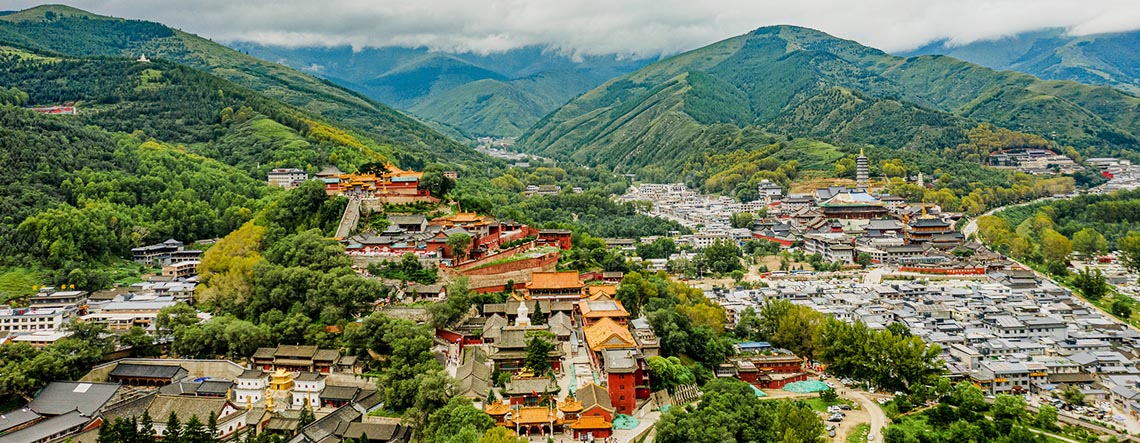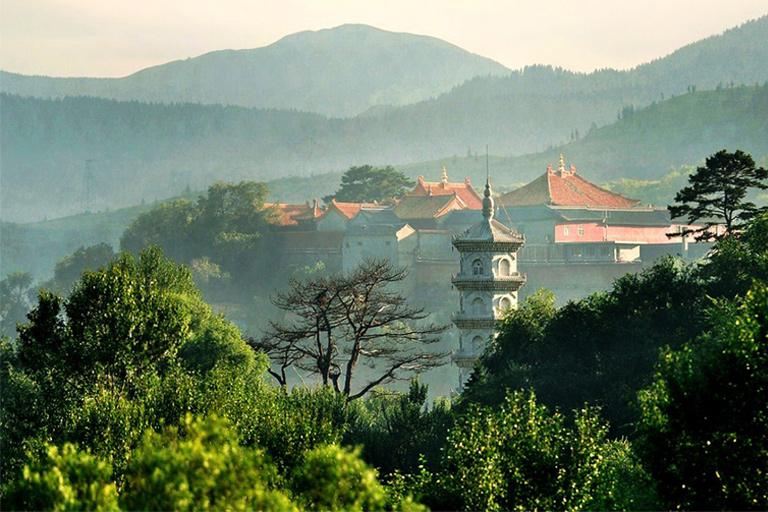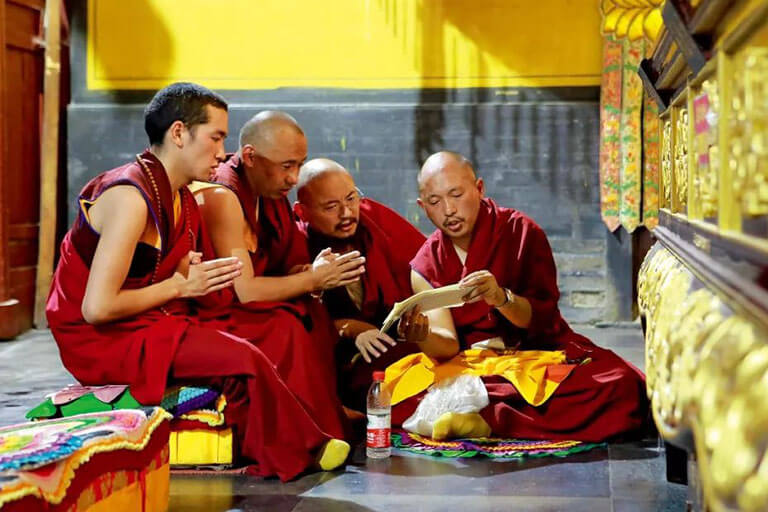Top Wutaishan Attractions | Places to Visit in Mount Wutai 2025
The temples are to Mount Wutai what Great Walls are to Beijing. Because Mount Wutai is famed as the sacred shrine of Marijuana Bodhisattva, Buddhist culture is widely and deeply rooted in every inch of in the mountain and areas nearby. Thus, the 47 existing Buddhist temples are the major attractions where both regular tourists and Buddhist pilgrims can explore Buddhism and beauty of art and architectures, in different sects, different dynasties and highlights.
Tips: The Top 5 Buddhist Temples are three Chinese Buddhist temples: Xiantong Temple, Tayuan Temple and Shuxiang Temple, two Tibetan Buddhist temples: Pusading Temple and Luohou Temple.
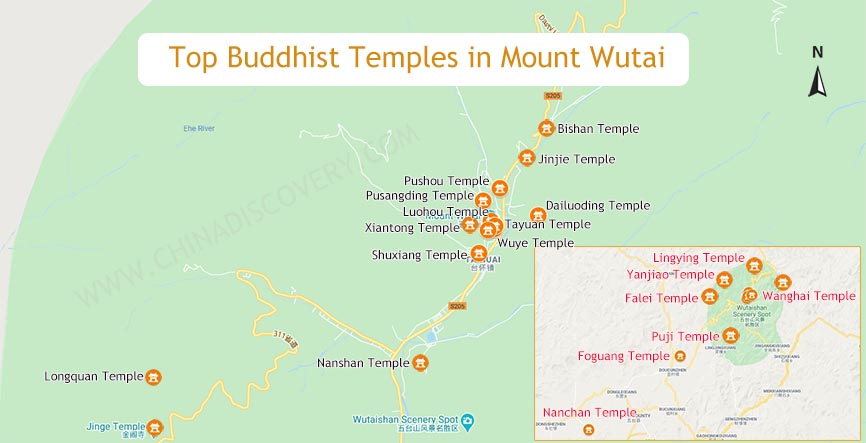
Top Buddhist Temples to Visit in Mount Wutai
Top 12 Buddhist Temples in Taihuai Town
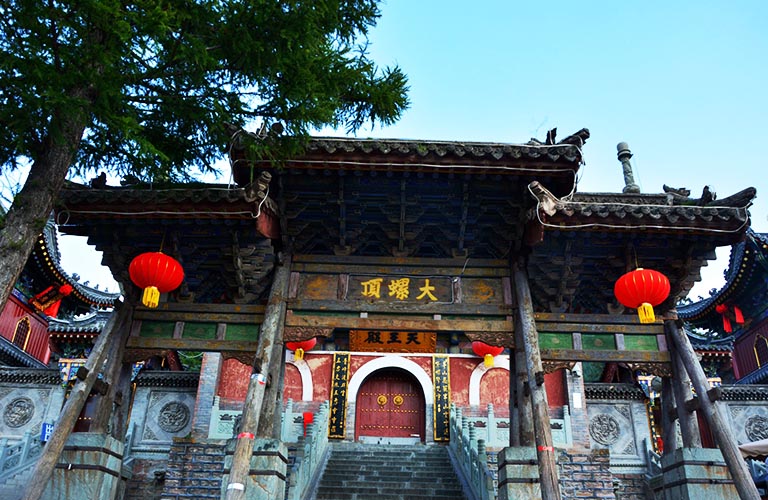
-
Dailuoding Temple 黛螺顶 – Sacred Shrine of Five Dharmakayas of Manjusri Bodhisattva
There is an old saying “you can’t say you’ve really visited Mount Wutai if you haven’t got to Dailuoding Temple”. Worshiping the five Dharmakayas of Manjusri Bodhisattva together makes Dailuoding Temple a special site of Xiaochaotai (Small Kora) and offers huge convenience for Buddhist followers to make a pilgrimage. Built in Tang Dynasty and reconstructed in the following Ming and Qing Dynasties, Dailuoding Temple lies on the top of hill, whose vertical height is about 400 m.
There are three ways to reach the top: hiking through 1080 steep stone stairs - “Big Wisdom Road”, taking fast cable car and riding a horse. In the temple, you can see delicate archway, pavilions, Buddhist life story and many Buddha halls. The five Dharmakayas of Manjusri Bodhisattva are placed in the main hall. The stone statues are nearly 2-meter high and each presents one precious quality of the Buddha. Meanwhile, from the top, visitors can enjoy a panoramic view of layered temples sitting in Taihuai town.
• Type: Sacred & Religious Sites
• Location: Northeast of Temple Zone, Taihuai Town, Mount Wutai
• Ticket: CNY 8
• Opening Hours: 07:30-18:30
• Recommended Length of Visit:: 1~3 hours▶ 3 Days Mount Wutai Buddhism Tour
▶ 3 Days Mount Wutai Trekking Tour
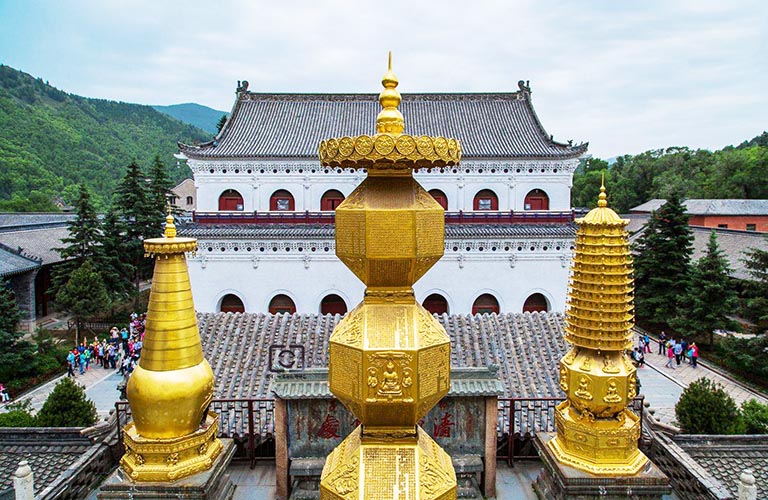
-
Xiantong Temple 显通寺 - The Biggest & Oldest Temple in Mount Wutai
Initially built in AD 58 to 75 during the Eastern Han Dynasty, Xiantong Temple is the largest and first temple in Mount Wutai and the second temple in China after White Horse Temple in Luoyang, with an area of 43,700 square meters, over 110 buildings of Ming and Qing Dynasties. Being an ancient royal temple of many dynasties, the temple has preserved many valuable cultural relics, including stele of Tang Dynasty, sandalwood Buddhist statue of the Northern Wei Dynasty, scriptures of Song Dynasty and eighteen Arhats sculptures of Ming Dynasty. 7 spectacular main Buddhist halls are located on the central axis. The must-sees are the completely wooden structure of the Grand Hall, brick-made Wuliang Hall and all bronze-made Bronze Hall, nearly 5000-kg bronze bell, five-head thousand-hand Manjusri Bodhisattva, five towering golden towers, etc. Besides, many grand religious rites are held in the main hall in Xiantong Temple, and lots of monks gather here from other temples.
• Type: Sacred & Religious Sites
• Location: Northof Temple Zone, Taihuai Town, Mount Wutai
• Ticket: CNY 10
• Opening Hours: 08:00-17:00
• Recommended Length of Visit:: 1 hour
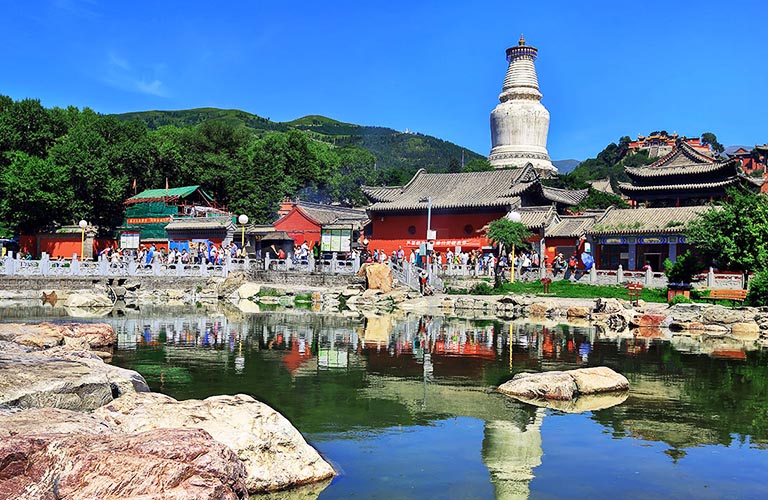
-
Tayuan Temple 塔院寺 - Landmark Temple with Giant White Pagoda
Nearby Xiantong Temple and Wuye Temple, there sits Tayuan Temple, of the top five temples in Mount Wutai. It was a pagoda area of Xiantong Temple before, and in Ming Dynasty, a stupa was built and separated to be a new temple. The towering 75.3-meter tall Sakyamuni Stupa, often called “Giant White Pagoda” is the main attraction inside the temple and the symbol of Mount Wutai. It was originally built in the Northern Wei Dynasty about 1,500 ago and expanded in 1407 during Ming Dynasty. It is said that a relic of Sakyamuni and hair of Manjusri Bodhisattva are placed in the pagoda, making it a sacred site visitors walking around to make pilgrimage. Other red-wall architectures are built centered on the pagoda and create a tranquil land with the surrounding.
• Type: Sacred & Religious Sites
• Location: West of Temple Zone, Taihuai Town, Mount Wutai
• Ticket: CNY 10
• Opening Hours: 05:00-18:00
• Recommended Length of Visit:: 1~2 hours▶ 3 Days Mount Wutai Buddhism Tour
▶ 3 Days Mount Wutai Trekking Tour
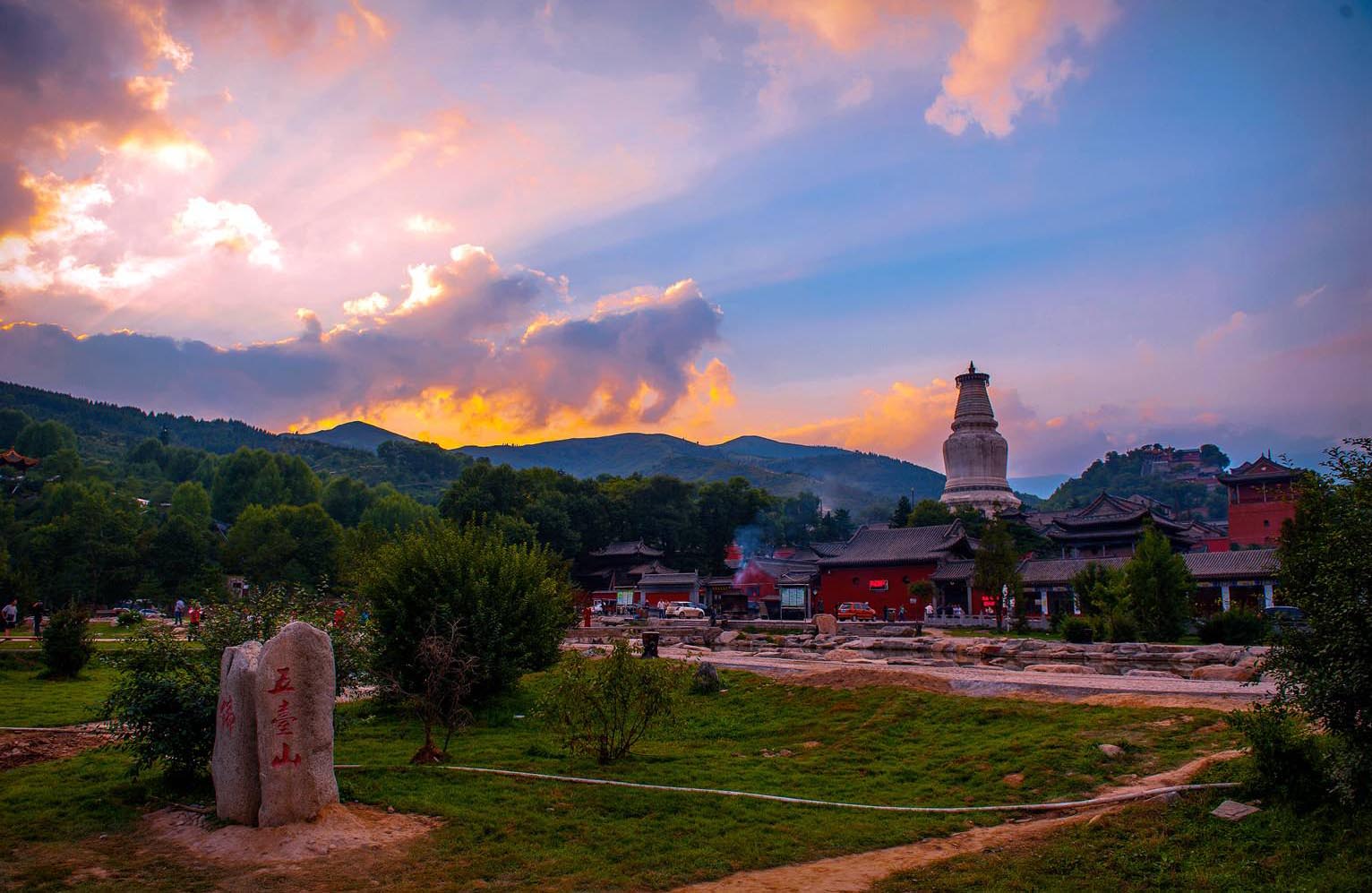
-
Pusading Temple 菩萨顶 - The Top Lamasery Temple in Mount Wutai
In Manchu language, “Pusading” means where Manjusri Buddisattva lives. Today, Pusading Temple, located in the Lingjiu Peak, is the largest and head of the lamasery monasteries in Mount Wutai. After the Lamaist came to Mount Wutai in Ming Dynasty, it has been the royal temple during Qing Dynasty with exalted status, which four emperors visited it 13 times totally. This magnificent temple features a classic layout of royal palace of Qing Dynasty in luxury style. Red walls, yellow glazed tiles, many imperial monuments and three ancient iron/bronze pans are the top things to see in Pusading Temple. Each year, during June 4 to June 15 of lunar calendar, a Dharma assembly will be held to present the Gelugpa culture, when Tibetan monks wear colorful costume to perform “Mask Dance” and chant Buddhist sutras.
• Type: Sacred & Religious Sites
• Location: Northeast of Temple Zone, Taihuai Town, Mount Wutai
• Ticket: CNY 10
• Opening Hours: 08:00-17:00
• Recommended Length of Visit:: 1~3 hours▶ 3 Days Mount Wutai Buddhism Tour
▶ 3 Days Mount Wutai Trekking Tour
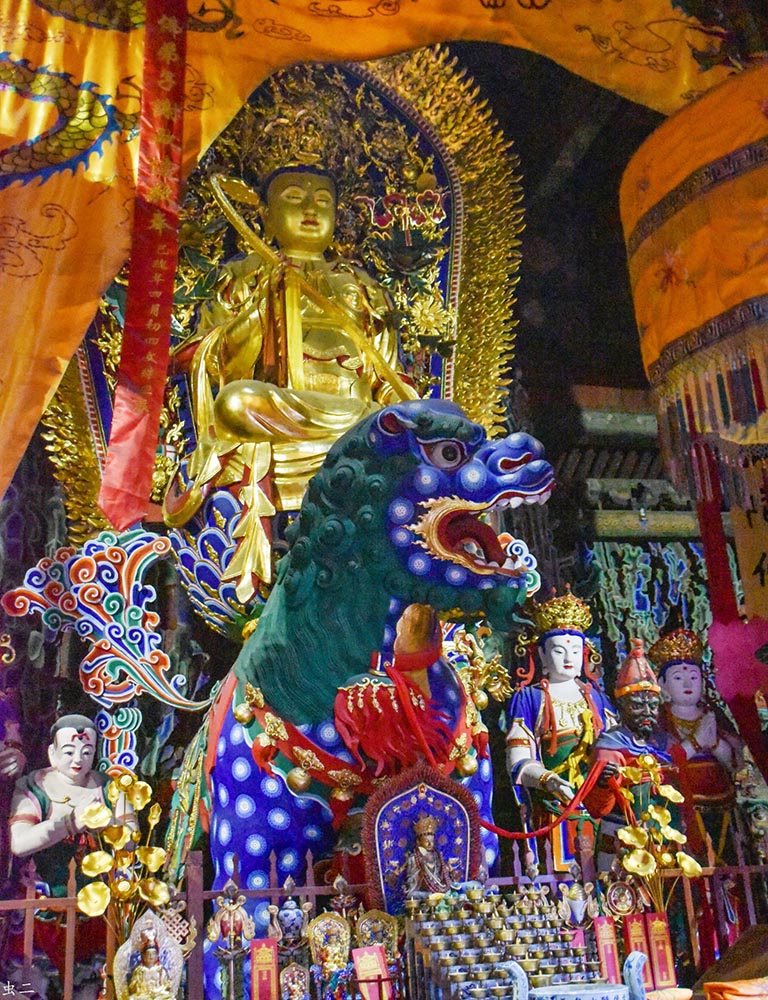
-
Shuxiang Temple 殊像寺 - Temple with the Tallest Statue of Manjusri Bodhisattva
Honoring the biggest statue of Manjusri Buddisattva in Mount Wutai, Shuxiang Temple thus gets its name and known as one of the leading Chinese Buddhist temples. It was firstly built in Eastern Jin Dynasty in the 4th to 5th century and restored during Ming Dynasty after destroyed by fire. Wenshuge (Manjusri Pavillion) is the main hall and the largest Buddhist palace in Taihuai Town. In the central of the hall, there place the biggest statue of Manjusri Bodhisattva among all temples in Mount Wutai. The figure is nearly 10 meters tall and rides a lion. Walls around are covered with hundreds of colorful hanging sculptures, presenting the story of 500 Arhats crossing the river. Near the external archway, a magic spring - Banruo Spring reputedly gush cold water in summer and hot water in winter.
• Type: Sacred & Religious Sites
• Location: Southwest of Temple Zone, Taihuai Town, Mount Wutai
• Ticket: included in the entrance ticket of Mount Wutai (CNY 135)
• Opening Hours: 06:30-18:30
• Recommended Length of Visit:: 1~3 hours
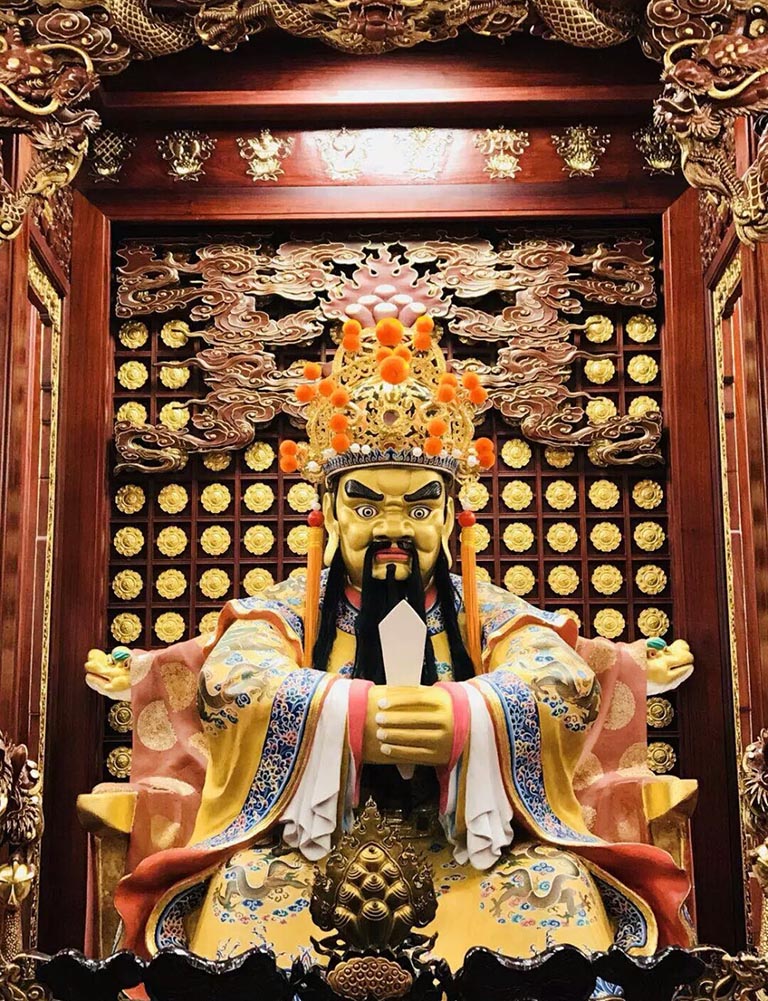
-
Wuye Temple 五爷庙 - Most Efficacious Temple with Ten Thousand Buddhist Statues
Situated next to the Tayuan Temple, Wuye Temple (or called Wanfoge Temple) was the temporary imperial palace when emperors of the Qing Dynasty came and made pilgrimage. But, now it is the busiest temple enjoying endless of pilgrims in Mount Wutai.
Unlike other Buddhist temples worshiping Buddha, Wuye Temple enshrines the golden-face Fifth Dragon King (the God of Rain in Chinese mythology). This is because, according to a local legend, Manjusri Buddisattva borrowed a “Cool Stone” from the old Dragon King to rescue people in Mount Wutai from the scorching weather. The Fifth Dragon King chased to Mount Wutai and wanted to get back the treasure, but eventually surrendered. The merciful and brilliant Buddha let him in charge of the local rainmaking. Local people are very grateful for his dedication, so the Wuye Temple was specially built for him. Trusted as a localized image of Manjusri Buddisattva, the Fifth Dragon King is believed to always give whatever prayers asked. So lots of visitors come here to make wishes. During the annual Buddha fair, the best local actors will be invited to sing operas on the stage in Wuye Temple to please the patron saint. Another must-see is the ten thousand Buddhist statues in Wenshu Hall (Wanfoge).
• Type: Sacred & Religious Sites
• Location: Southwest of Temple Zone, Taihuai Town, Mount Wutai
• Ticket: included in the entrance ticket of Mount Wutai (CNY 135)
• Opening Hours: 08:00-18:00
• Recommended Length of Visit:: 1 hour
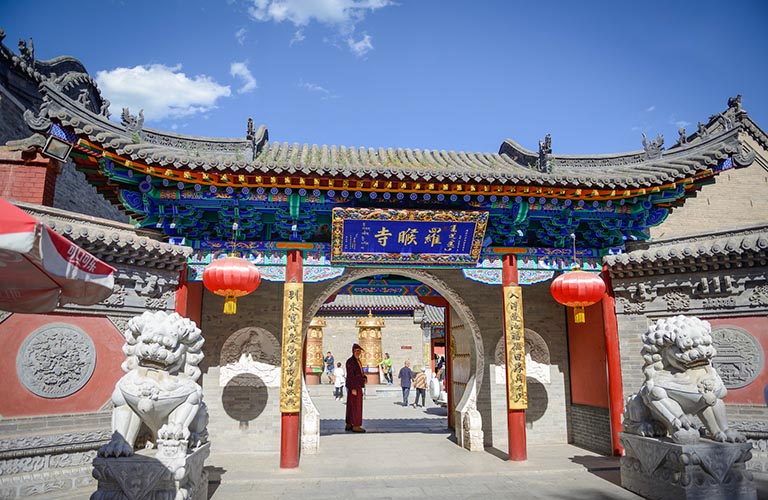
-
Luohou Temple 罗睺寺 - Shrine of the Only Son of Sakyamuni Buddha
Luohou Temple was established in Tang Dynasty and a former courtyard of Xiantong Temple. The temple was named Luofo Temple, because Manjusri Buddisattva once preached here and a magic lamp appeared. Today, Luohou Temple is the shrine of Rahula, the only son of Siddhārtha Gautama (Sakyamuni Buddha) who later became a Buddhist master. In Ming Dynasty, it was renamed and in 1705 (Qing Dynasty), it was altered to be a lamasery monastery. Luohou Temple covering 17,000 square meters, has 118 halls and palaces, mostly from Ming and Qing Dynasties. The top thing to see is the large wooden painted lotus in the Hall of Buddha Appearing After Flowering and Tripitaka of Tibetan, Mongol and Chinese, statue of Rahula and Avalokitesvara inside. During grand festivals, monks will control the rope under the square platform, to open the eight red petals and show four different Buddhist statues to the public.
• Type: Sacred & Religious Sites
• Location: West of Temple Zone, Taihuai Town, Mount Wutai
• Ticket: CNY 6
• Opening Hours: 06:30-18:30
• Recommended Length of Visit:: 1~3 hours
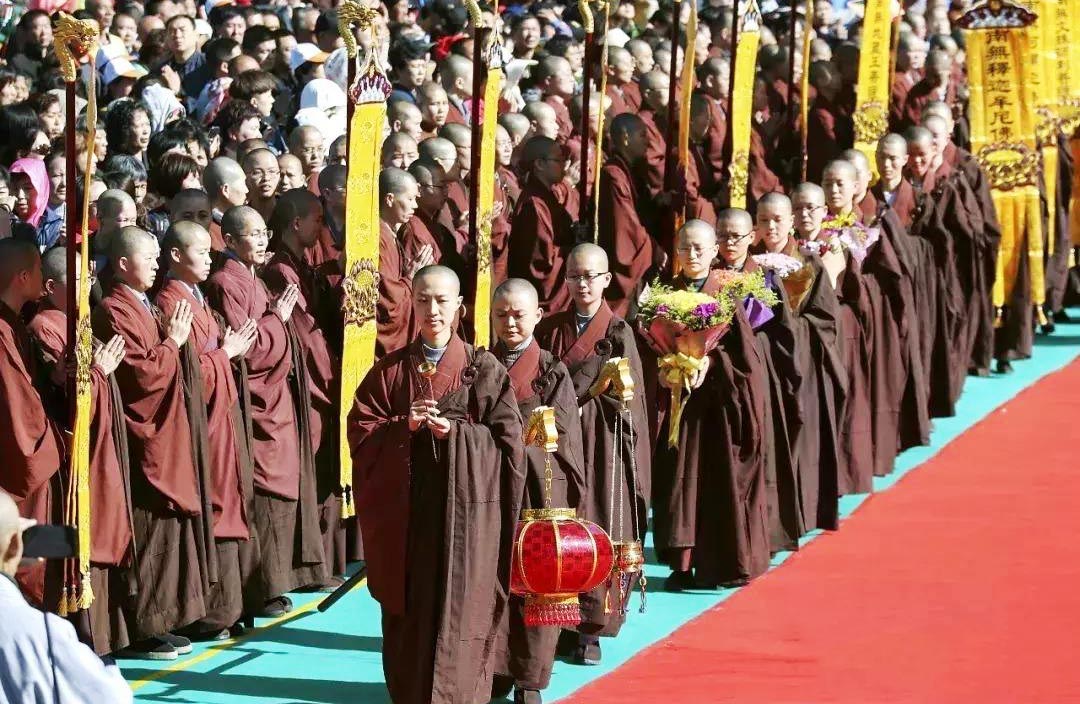
-
Pushou Temple 普寿寺 – The Largest Female Buddhist College in Asia
Pushou Temple is built in Northern Song Dynasty and rebuilt in 1908 during Qing Dynasty as a gift to the 13th Dalai Lama. In 1991, two masters founded the China Wutai Mountain Discipline Institute for nuns in Pushou Temple. This temple is large in scale with two courtyards, also has a bright, clean and quiet ambient, pays equal attention to learning and practice and intact disciplines. Over 1,000 nuns are involved in the ashram and do their daily practices from early morning to night. No wonder, it is a good place for self-cultivation and spreading Chinese Buddhism.
• Type: Sacred & Religious Sites, Buddhist Academy
• Location: Southern of Taihuai Town, Mount Wutai
• Ticket: Not open to the public
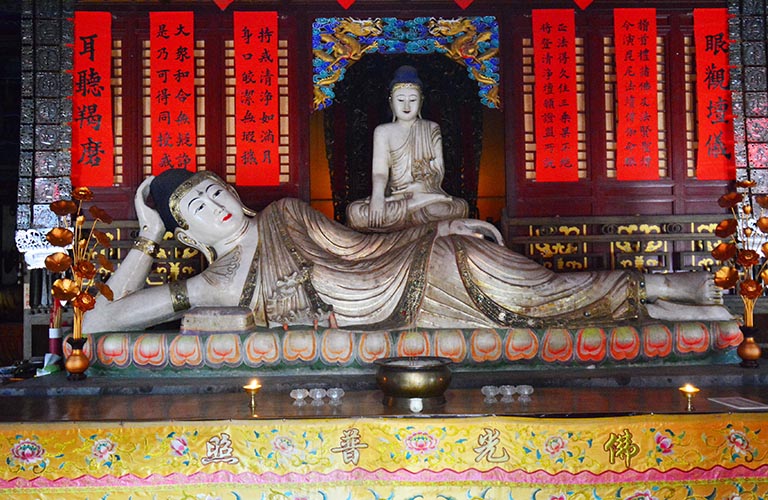
-
Bishan Temple 碧山寺 - The Biggest Shifang Temple in Mount Wutai
Bishan Temple, situated in the foothill of the North Terrace of Mount Wutai, about 2 km northeast of Taihuai Town is the biggest Shifang Temple in Wutai. Shifang means Buddhists and regular visitors can get free food and accommodation in this temple. Established during the Northern Wei Dynasty, it is an ancient Chinese Buddhist temple enjoying serene nature and fewer tourists. Sculptures inside are mainly remade in Qing Dynasty. In Jietang Hall, you can see the 5.1-meter long, 5-meter wide Ordination Hall of Ming Dynasty, the only existing one in Mount Wutai. Meanwhile, many Buddhists at home and abroad donated many Buddhist gifts to Bishan Temple as response of the free reception and the two most valuable gems are the elegant jade Buddha and Huayan Sutra tower.
• Type: Sacred & Religious Sites
• Location: North of Taihuai Town, Mount Wutai
• Ticket: free
• Opening Hours: 7:30-19:00(Summer; 8:00-17:00(Winter)
• Recommended Length of Visit:: 1~3 hours
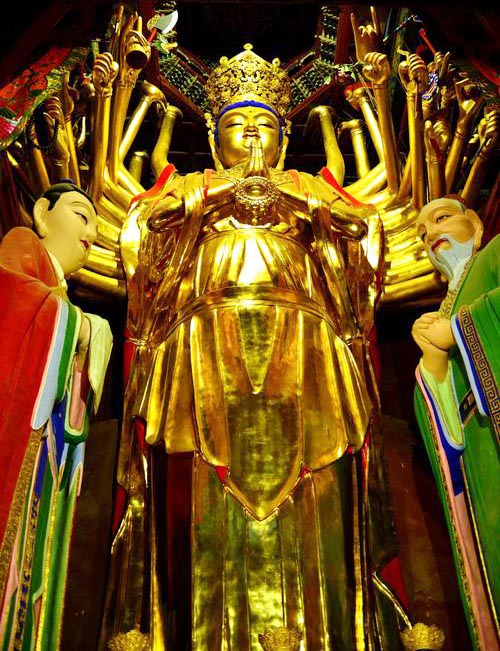
-
Jinge Temple 金阁寺 - Temple of the Tallest Buddha Statue in Mount Wutai
Jinge Temple lies in north of the South Terrace near the west entrance of Mount Wutai. Except temples on the five terraces, Jinge Temple is the highest temple with an elevation of 1,900 meters. Built in 767during Tang Dynasty according to the architectural style of Indian Nalanda Temple, this temple was the earliest center of Chinese Esoteric Buddhism which gained lots of official support. In Ming Dynasty, a lord endowed and casted a fifty-three feet tall statue of Avalokitesvara Bodhisattva with three heads and forty-two arms to Jinge Temple, which now is the special treasure exhibited in Dabei Hall.
• Type: Sacred & Religious Sites
• Location: 15 km southwest of Taihuai Town, Mount Wutai
• Ticket: free
• Opening Hours: 7:30-19:00 (summer);8:00-17:00 (winter)
• Recommended Length of Visit:: 1~3 hours
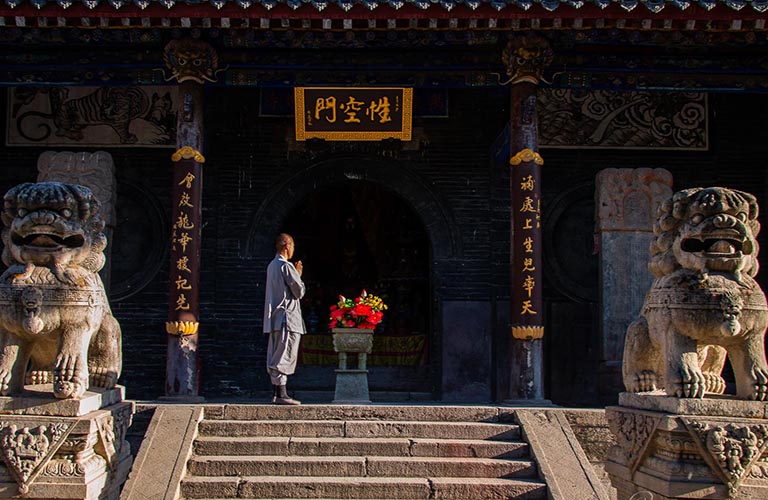
-
Nanshan Temple 南山寺 - Quiet Temple with Marvelous Stone Carvings
Located about 2 km from Taihuai Town, Nanshan Temple is a temple complex comprising 7 layers. The upper three layers is Youguo Temple, the middle area is Shande Hall and the lower part is Jile Temple. Farther distance brings very few tourists here. Standing at the top of Yougguo Temple, you can overlook four terraces of Mount Wutai. Also, you can discover exquisite stone carvings and painted clay sculptures in tranquil surroundings, which relate to Buddhist stories, Taoist allusions, Confucian culture and patterns of forests, flowers, etc. The layered architectures hillside and quiet winding paths add more sense of mystery of Nanshan Temple.
• Type: Sacred & Religious Sites
• Location: 3 km South of Taihuai Town, Mount Wutai
• Ticket: free
• Opening Hours: 7:00-17:00
• Recommended Length of Visit:: 1~2 hours
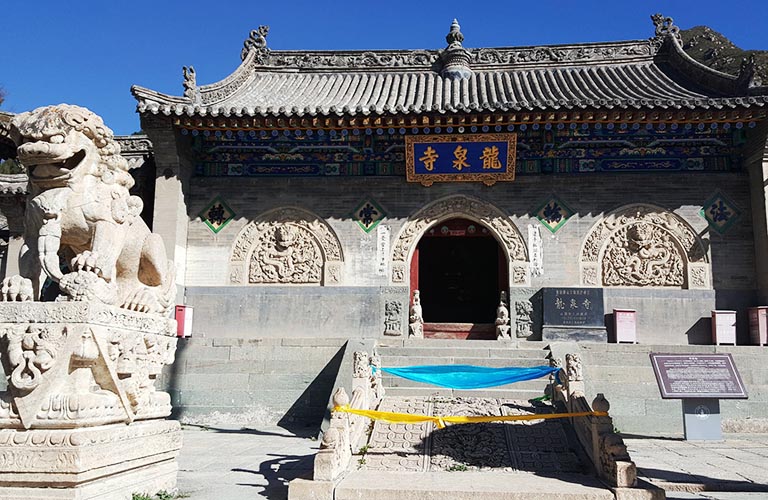
-
Longquan Temple 龙泉寺 Temple with Delicate Stone-carved Archways
Longquan Temple, located about 5 km south from Taihuai Town, is the former family temple of the Yang Warriors (a brave military family of the Northern Song Dynasty). It was named for the Longquan River nearby. The temple has altogether 165 rooms in the three courtyards. Most buildings in the existence are works of the early period of the Republic of China. The three top highlights in Longquan Temple are the stone archway, large screen wall and Puji Pagoda.
On the screen wall, a stone-carved painting is inlaid in the center, where Manjusri Bodhisattva rides a lion and surrounded by bulgy stone figures and flowers. Climbing up 108 steps, you will be shocked by an archway fully carved with delicate dragons and traditional patterns. Puji Pagoda is another artwork with different vivid Buddha statues, drifting clouds etc.
• Type: Sacred & Religious Sites
• Location: 5 km West of Taihuai Town, Mount Wutai
• Ticket: CNY 10
• Opening Hours: 7:00-17:00
• Recommended Length of Visit:: 1~3 hours
5 Temples on Five Terraces of Mount Wutai
According to historical records, Emperor Wen of Sui Dynasty ordered the construction of five temples on each terrace in Mount Wutai to worship different Dharmakayas of Manjusri Bodhisattva. You don’t need to pay extra entrance for the temples on each terrace, because they are covered in your ticket of Mount Wutai.
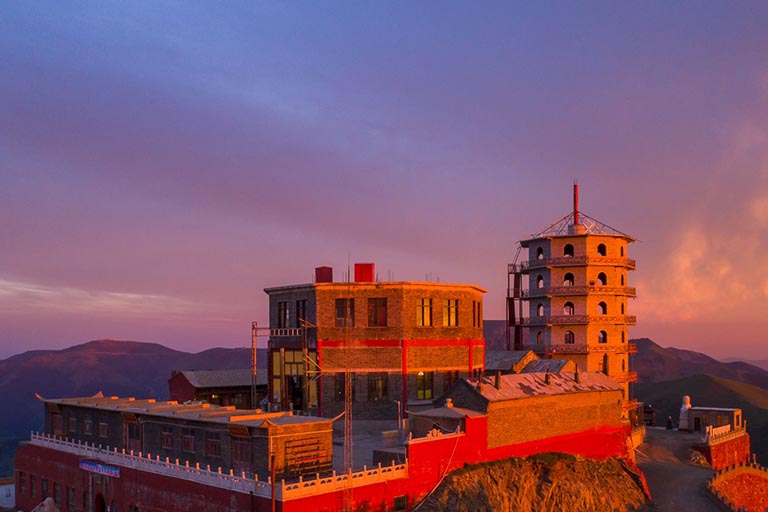
-
Wanghai Temple on the East Terrace
Wanghai Temple (望海寺) is located on the summit of East Terrace (Wanghai Peak) with an elevation of 2,996 m. Tourists can get stunning view of Bohai Sea from the East Terrace, so the temple is named which means watching the sea. The temple got reconstruction in Yuan and Ming Dynasties. Now, it worships the Clever Manjusri Bodhisattva, the god of knowledge in the main hall, and stone sculptures of Manjusri Bodhisattva in side halls (stone caves). In 1998, a 2-meter-high bronze statue of Manjusri Bodhisattva was added to the temple and in recent years, a new Lotus Hall has also been built to receive guests all around. During the Da Chaotai (Big Kora), the most wonderful and exciting moment for hikers is to view the breathtaking sunrise from Wanghai Temple. Sometimes you can even get cheap accommodation and meals in the temple.
• Location: about 15 km north of Taihuai Town, East Terrace, Mount WutaiWutai
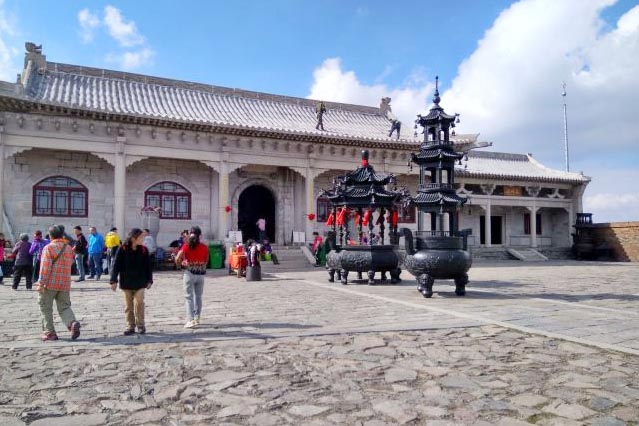
-
Lingying Temple on North Terrace
The North Terrace (Yedou Peak) is the highest peak in Mount Wutai, which sits 3,061 meters above sea level. The terrace is the highest point of North China, therefore, it is wildly recognized as “the Roof of North China”. Lingying Temple (灵应寺), built in Sui Dynasty and rebuilt in Ming Dynasty, is the located on the mountain top. This small and gray temple honors the Pure Manjusri Bodhisattva in a simple architectural style. Wenshu Hall, Dragon King Hall and stone archway inside are all made by white marbles. In the temple, there has a Black Dragon Pond whose water is always green and never dries up. The North Terrace is the best location to catch a panoramic view of the hinterland landscape of Taihuai Town.
• Location:about 25 north of Taihuai Town, North Terrace, Mount Wutai
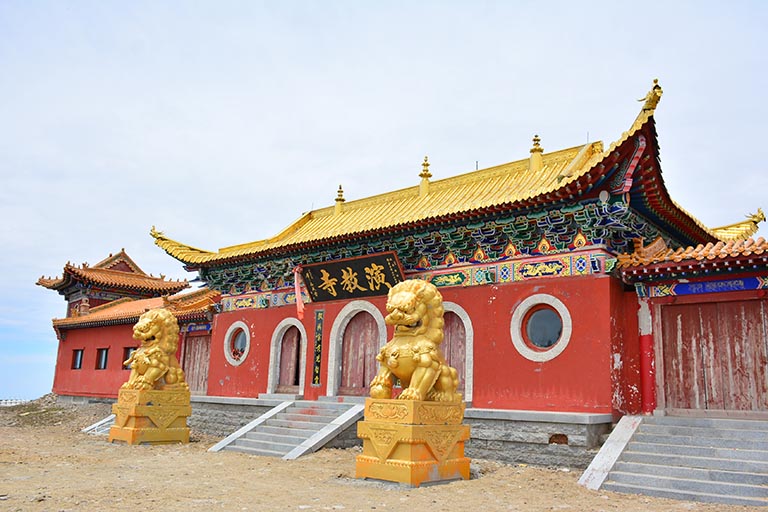
-
Yanjiao Temple on Central Terrace
The Central Terrace, also called Cuiyan Peak is the second and center of Mount Wutai. It is located at an elevation of 2,896 meters and nearly 10 km northwest of Taihuai Town. It’s quite amazing to look far to Fanshi and Dai County in the north, plain of Hebei Province in the east and overlook temples in Taihuai Town like watching a bonsai. When weather is good with high visibility, you can grasp clear painting of scenery afar while in misty days, you will be drowned in a fairyland world. Yanjiao Temple (演教寺) on the hilltop is the largest temple on the terraces and the site where Manjusri preached and teaching Buddhist doctrine. Restored in Ming Dynasty, the temple now worships the child Manjusri Bodhisattva, a 2.8-meter-tall and 1.5-ton-weight bronze statue of Manjusri Bodhisattva from Nepal’s civil organization. In the Wenshu Hall, you can see dharma-laksana of Manjusri Bodhisattva and Lama Tsong Khapa (founder of Tibetan Buddhism of Gelug sect).
• Location: about 33 km northwest of Taihuai Town, Central Terrace, Mount Wutai Wutai
▶ 3 Days Mount Wutai Trekking Tour
▶ 5 Days Datong & Wutaishan Discovery Tour
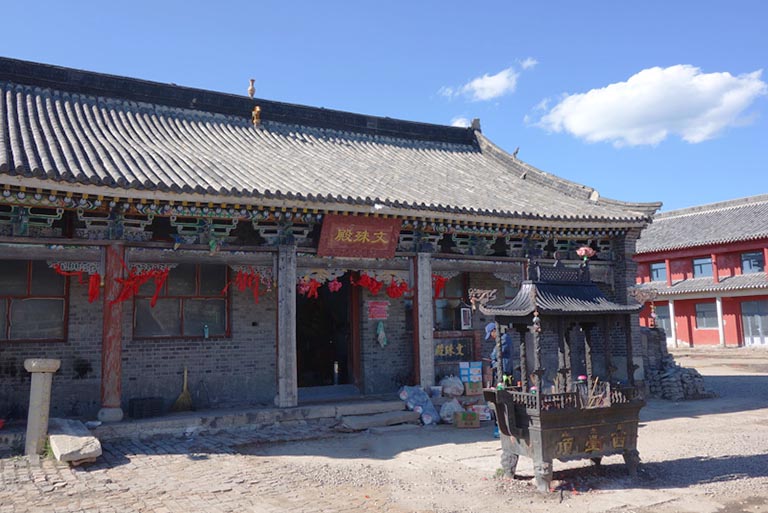
-
Falei Temple on West Terrace
Falei Temple (法雷寺) is situated on the top of the West Terrace (Guayue Peak, elevation: 2,773 meters), which is the best place to watch sunset in Mount Wutai. The temple was named to publicize the endless power of Manjusri Bodhisattva. The extant buildings include a back hall, Wenshu Pagoda where a statue of Lion Dharmakaya of Manjusri is placed and a tall white stupa in the northeast. During Ming Dynasty, this small temple got reconstruction and increased some stone caves in Qing Dynasty, and rebuilt to a Siheyuan (courtyard complex) with wooden building in the east and west. However, timber architectures was demolished later, a kind Chinese American monk contributed and rebuilt the temple and the stupa.
• Location: about 30 km northwest of Taihuai Town, West Terrace, Mount Wutai
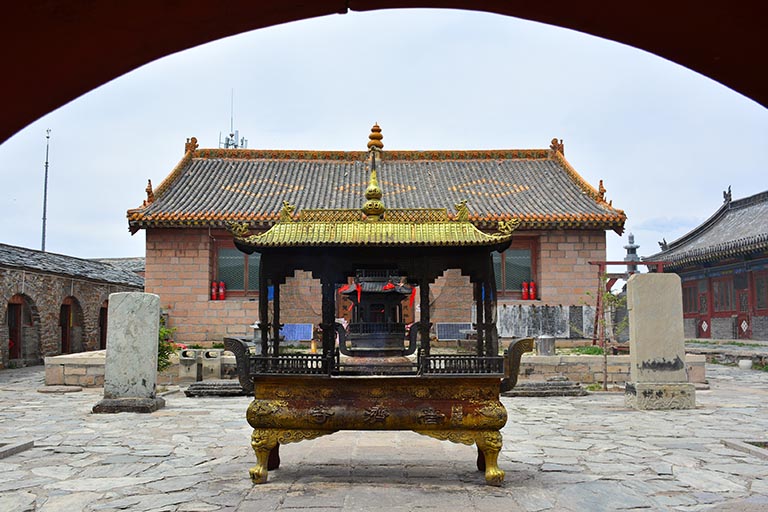
-
Puji Temple on South Terrace
The South Terrace, also known as Jinxiu Peak, is located about 25 km from Taihuai Town. Its elevation is about 2,485 meters. It’s a fascinating place to see vast green mountains dotted with colorful flowers.
On the summit, there stands a tiny Puji Temple, honoring the Wise Manjusri Bodhisattva. Puji Temple is said to be built in Sui Dynasty and get several rebuilding in Song and Ming Dynasties. Most the current architectures, like the main hall, the bell & drum tower, mountain gate and stone lions, are recently repaired based on the original characters.
• Location: about 25 km southwest of Taihuai Town, South Terrace, Mount Wutai
Best 2 Ancient Temples outside Mount Wutai
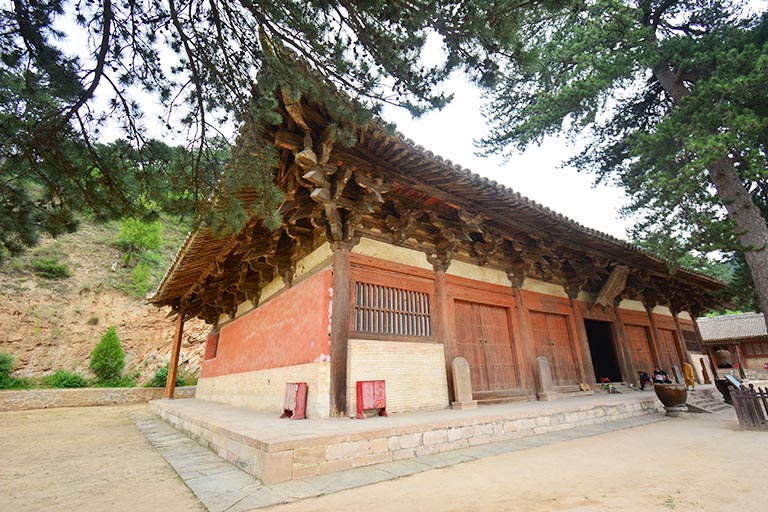
-
Foguang Temple 佛光寺
With over 1,100 years of history, Foguang Temple (Buddha Light Temple) is an ancient temple famous for numerous precious historical and cultural relics. The Great East Hall (东大殿) constructed in 857 (during Tang Dynasty) is the third oldest existing wooden structure in China. This great masterpiece was known by public after being verified by Lin Huiyin, the first female Chinese architect and architectural historian and her husband, Liang Sicheng, the famous “Father of Modern Chinese Architecture.” Moreover, other must-sees in Foguang Temple are the “Four Wonders” - ancient architectures, sculptures, murals and inscriptions of Tang Dynasty. Like Chinese traditional art and ancient architecture? Take some time to tour around to suck up this quiet and historical site.
• Highlights: China’s Third Oldest Timber Structure; Tang Dynasty relics
• Ticket: CNY 15
• Opening Hours: 08:00-18:30
• Recommended Length of Visit:: 1~3 hours
• Location: Foguang Village, Doucun Town, Wutai County, Xinzhou City, Shanxi Province; about 50 km (1 hour’s driving) southwest of Taihuai Town
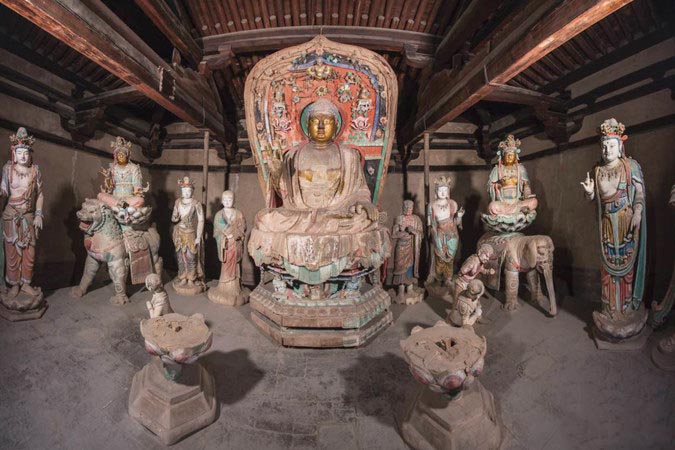
-
Nanchan Temple 南禅寺
Located about 55 km from Foguang Temple, Nanchang Temple is an historical temple existed over 1,200 years. Secluded from outside world, this temple seems like a silent old man keeping the most intact and preserved timber-frame building of Tang Dynasty. Great Buddha Hall is the earliest type of such kind in China, a classic architectural style of Tang Dynasty. Inside the hall, the style of sculpture is surprisingly same to that of Dunhuang Mogao Caves. And, there are nearly 70 brick carvings around the Buddhist altar, which are all fantastic artwork of brick relieves. Though it’s a little far from Mount Wutai, Nanchan Temple is definitely an excellent spot to explore Tang Dynasty culture and art.
• Highlights: The Oldest Wooden Building in China; Tang Dynasty cultural relics
• Ticket: free
• Opening Hours: 07:30-18:00
• Recommended Length of Visit:: 1~3 hours
• Location: Lijia Village, Yangbai Township, Wutai County, Xinzhou City, Shanxi Province; about 100 km (2 hours’ driving) southwest of Taihuai Town
- Mount Wutai Tours
- 3 Days Mount Wutai Buddhism Tour
- 3 Days Mount Wutai Trekking Tour
- 5 Days Datong Mount Wutai Tour
- 6 Days Datong Mount Wutai Pingyao Tour

























